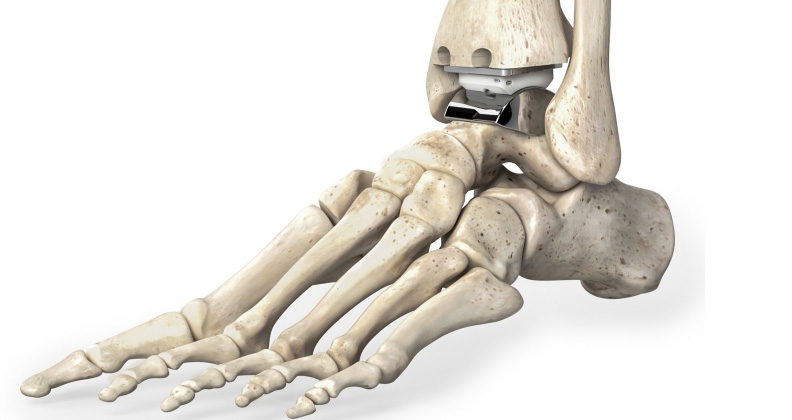
Orthopedic companies with a growth mindset are quickly realizing that new opportunities lie in foot and ankle. Its subsegments are among the fastest growing within the joint replacement and trauma markets. Large- and mid-tier companies are acquiring smaller players to fill product portfolios with solutions for replacing joints, repairing fractures, correcting deformities and fixing bunions.
It’s no wonder that Paragon 28 CEO Albert DaCosta recently called foot and ankle the “last remaining gem in orthopedics.” That’s high praise for a space that has been overshadowed in recent years by buzzy innovations in the joint replacement and enabling technology markets.
“Foot and ankle is getting more attention. When that happens, you see more innovations and improved surgical outcomes,” said Ryan Schlotterback, President and CEO of BioPoly. Schlotterback has spent years driving new technology in the lower extremity space. He now runs a company that offers Great Toe and Lesser Toe hemiarthroplasty implants, which are made of a proprietary combination of polyethylene and hyaluronic acid that behaves like synthetic cartilage.
The segment presents an intriguing landscape that has a potential customer base of about 16,000 surgeons and an accessible patient population, according to Gary Justak, President and General Manager of Foot & Ankle at Enovis. The company has been the most active orthopedic player in M&A since 2020, conducting eight acquisitions to build its foot and ankle business.
Justak said the market’s main driver is the high prevalence of arthritis, osteoarthritis, obesity, diabetes and bunions. “This unique space is characterized by complex and intricate anatomy, and relatively high patient dissatisfaction scores,” he added. “It’s primed for innovation as companies continue to invest in new technologies that further enhance patient care.”
Maintaining Natural Motion
BioPoly initially focused on developing solutions that repair damaged joints in the forefoot, particularly painful great toe conditions such as hallux rigidus and hallux limitus. Recent interest in solutions that focus on the lesser toes has increased significantly due to the scarcity of available treatment options, according to Schlotterback.
BioPoly’s Great Toe and Lesser Toe hemiarthroplasty implants are off-the-shelf solutions that target only the damaged area of the first metatarsal joint and offer potential advantages to standard treatment options. Biologic solutions demand waiting for the appropriate graft and involve complex and expensive cultivation processes. Traditional metal implants contribute to the erosion of cartilage over time.
“We can customize a range of implants to suit the patient’s anatomy to provide immediate functionality,” Schlotterback said. “Patients typically experience increased activity levels on the day of surgery as the implants effectively address the painful area of the joint. The material’s properties offer a cost-effective treatment option with long-term viability.”
The midfoot and ankle regions are also exciting areas of innovation, Schlotterback noted. “Companies can create treatments for damaged cartilage that reduce pain and improve joint movement. They can also enhance long-term function and help patients return to their daily activities faster.”
Developing motion-preserving technology and proactively treating foot and ankle conditions allows companies to meet the clinical needs of younger patients who want to resume active lifestyles without waiting years for relief of chronic and debilitating pain.
“The days of telling patients to deal with discomfort and loss of function until they get a total joint replacement are over,” Schlotterback said. “Patients are demanding solutions that keep them active earlier. They don’t want surgeons to fuse bones in the foot and ankle. They want to undergo surgery that maintains a range of motion in their joints.”
According to Schlotterback, real innovation occurs when product developers change their focus from fusing bones to preserving the natural movement of joints. “Industry is focused on catching pathology earlier and addressing it effectively,” he added.
Dynamic Personalized Care
Envois wants to develop innovative new treatments instead of remaking slightly altered versions of devices made by “me too” companies.
“Plates and screws are needed, but there are limited ways to drive differentiation other than altering the thread pitch of a screw or the angulation of a locking mechanism,” Justak said. “There aren’t many companies that are trying to improve foot and ankle outcomes as the main driver of new business.”
Enovis will use its Scandinavian Total Ankle Replacement (STAR Ankle) mobile bearing implant as the cornerstone to increasing market share in the total ankle space, according to Justak.
In December 2022, the company received FDA approval for its STAR Patient-Specific Instrumentation (STAR PSI), which will be a core aspect of the platform moving forward. STAR PSI provides surgeons with a preoperative plan for individual patients and creates a 3D model of the patient’s ankle joint, including the location of existing implants or bone defects.
Justak said Enovis is doubling down on developing personalized surgery in ways that are repeatable and scalable, especially for high-volume procedures. The company plans to introduce its ARVIS augmented reality (AR) platform in the foot and ankle segment to meet those goals, according to Justak.
“This advancement in total ankle replacement would reduce reliance on PSI and instead incorporate pre-planned aspects into surgery,” he said. “We plan to use AR in increasing numbers of clinical areas that have more indications and procedures, like bunion correction.”
Envois is also focused on expanding the applications of Nitinol, a shape memory alloy that maintains constant compression after surgery. Justak said the concept behind applying Nitinol to fractures or fusion sites is based on the understanding of bone elasticity and remodeling, which has been extensively studied in clinical research.
“Static implants typically lose optimal compression immediately after insertion and as bone remodeling begins,” he explained. “We focused on using Nitinol to improve results in difficult areas with low fusion rates and high nonunion rates.”
Envois has built upon the success of the DynaNail TTC Fusion System, an internal compression nail made of Nitinol that optimizes hindfoot fusions. The company also expanded its Nitinol-based solutions for addressing subtalar applications, standard ankle fusions and challenging areas with limited blood flow like the talonavicular and calcaneocuboid joints in the midfoot.
“These efforts aim to improve outcomes in unique and difficult-to-treat regions,” Justak said.
Envois also wants to enter high-growth vertical markets, specifically by driving innovation within the bunion space. The company is planning to launch a fixation device in August for use during open Lapidus procedures.
The challenge of performing bunion surgery through small incisions lies in the limited visibility of the surgical field. AR offers a potential solution by providing real-time visualization of anatomical parameters like instrument angulation and rotation, and precise measurements of implant placement.
“AR will gain prevalence in foot and ankle, especially in high-volume procedures of the midfoot and forefoot, to propel innovation and reduce the reliance on personalized implants and instruments,” Justak said.
Minimally invasive orthopedic surgery is increasing in application and surgeon acceptance in the foot and ankle space. “Combining the clinical benefits of smaller incisions, which promote faster healing and a faster return to normal function, with innovative technologies creates opportunities to significantly improve long-term outcomes,” Justak said.
Reaching Surgeon Customers
Companies in the foot and ankle space must figure out ways to deploy distinctive technology across a diverse population of orthopedic surgeons. Justak believes that companies can benefit from the increasing interest in the segment by providing more fellowship opportunities and involving younger surgeons who are enthusiastic about advancing the field.
Envois’ recent acquisition of Novastep, which was finalized in April, meshes with its efforts to advance minimally invasive surgical techniques and capture more business. Envois wants to promote Novastep’s foot and ankle solutions by investing in simplified training for surgeons.
Connecting with surgeons and coaching them to become proficient in minimally surgical techniques is a significant challenge, Justak noted. Solving it, he said, creates a strong foundation for long-term success in a segment that’s poised for significant growth.
“We want to provide hands-on learning opportunities because minimally invasive surgery is a tactile and intuitive practice that cannot be easily replicated,” Justak said. “We’re determined to outpace the market by devising a meaningful and accelerated approach to surgeon education.”
DC
Dan Cook is a Senior Editor at ORTHOWORLD. He develops content focused on important industry trends, top thought leaders and innovative technologies.




